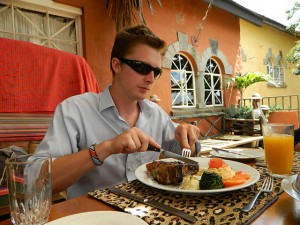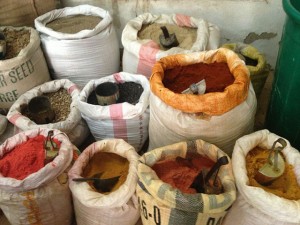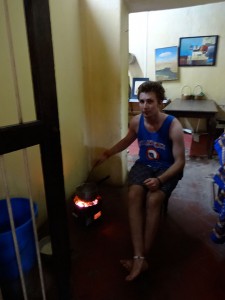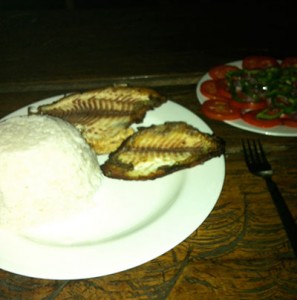Dinner in Mombasa
Those who read my post last week already know that I spent last semester living and learning on a St. Lawrence semester abroad program in Kenya. Others might like a bit of context; please bear with me for a minute.
I spent almost five months traveling and studying abroad earlier this year. During this time, I studied Kenyan culture, politics, conservation, history and language. This was a formative time for me–I grew as a student and an individual, constantly adding skills and stories to my repertoire.
Food is love, right?
Maybe I don’t agree with that mantra entirely, but I do love food. I love American food, French food, Italian food, Chinese food, Mexican food, Indian food, and more. Now, I love Kenyan food, too. After you finish reading this post, I trust you’ll understand why.
You learn a lot about a culture through its food. Local foods and the recipes used to prepare them tell stories history sometimes can’t. In our modern global culture where language, religion, art, and folklore are dying, lost, or forgotten, food lives. Food is one of the most pure and enduring aspects of culture, thriving from generation to generation.
While you may no longer have your grandmother’s fur boas or cigarette box lying around, I bet you have one or two of her recipes etched into your memory or folded into a coveted heirloom cookbook. Maybe you’ve even inherited the crock-pot or cast iron cookware she used for some of your favorite dishes back when you were a kid. Food and cooking are nostalgic and comforting. Food brings us back. Food keeps us going. Food lives.
Kenyan cuisine, especially on the coast, is very diverse. There, the food is inspired by centuries of tradition combined with a rich history of trade with Europeans and sailors from the Orient and the Arabian Peninsula. Kenyan food is as diverse as the people who serve it, a population that ranges from members of the 42 indigenous tribes to transplanted British and Italian expats. Centuries of trade with Asia have created a unique coastal culture that is evidenced well in the foods of the coastal Swahili people.
During my travels I spent a month living and learning in the heart of Old Town Mombasa, a city that is the economic center for millions of coastal residents and is among Kenya’s largest and oldest hubs. Predominantly Muslim and the home of the Swahili people, the old town has a culture and a food unique to the coast. There, seafood and spices meet in open-air markets and food is plentiful. I enjoyed a lot of Swahili food during my time in Mombasa and even learned to cook one or two dishes from a local Swahili mama (that’s the endearing term assigned to Swahili ladies).
Kenyan kitchens are much different from American kitchens. They can be set up in the street, in the hallway, in the stairwell, or even on the rooftop. They are simple, low maintenance, and full of excitement. Cooking over a wood-fired cooker produces a lot of heat, an aspect of cooking I had to get used to, considering I was already sweating while learning to peel potatoes with a machete in the heat of the afternoon sun. Sometimes in Mombasa, even in the shade it feels like it’s 100 degrees.
I had a blast combining foreign ingredients with spices I had only ever wondered about when I played with my mother’s spice rack as a child: Yellow rice, long brown rice, red rice, Indian saffron, cardamom, cinnamon, ginger and more. I was overwhelmed. Sometimes all I could do was take a step back from the busy kitchen and just watch, something I was quickly scolded by my mentor Mama Judy, who would laugh at me standing in the middle of the busy kitchen with my eyes large and my hands in my pockets.
My experience learning to cook was also culturally enriching. I had to do everything from gathering ingredients from the open-air market to building a fire for the coals I needed to cook over (thanks to countless camping trips with Boy Scouts, that was the only task I impressed them with).
Along the way I met several characters, including the Indian spice trader who had a friendly laugh at my expense when he asked me to identify spices. There was also the Omani butcher down the road who showed me how to butcher my chicken. And when I joked about not being able to make the same cuts with my dull knives, he told me to bring the knives to him and said he would sharpen them for me. That’s the way people are on the coast.
Combining spices and fresh seafood with ripe produce from upcountry, coastal cuisine is a food-o-phile’s dream. If only I had a couple more weeks to master some of the techniques. Anyways, now almost five weeks have passed since I returned to America, and I’m still struggling to recreate the meals I enjoyed over there. As a gift from my host family when I left I received a giant bag of cooking spices. Although I’m trying desperately to remember how they combine in dishes like spicy pilau rice dishes and curried chicken biryani, it’s simply not the same.
I’ll keep trying though, if only to bring back the memories of an amazing people and a new-found cuisine.
Through your own travels, is there a cuisine you came to love–and attempt to recreate in your own kitchen? Please share, including specific favorite foods from other countries.
Tags: food, foreign cuisine, Kenya, kenyan food













Fun post, Conant!
Food is an essential part of place, isn’t it?
On my only trip to Europe (thus far) my family enjoyed some super thick, very delicious hot chocolate at the Museu de la Xocolata in Barcelona – a museum devoted to chocolate. (‘Nuff said.)
My gosh, was that something!
We’ve tried to replicate that at home, but it’s never been as rich, as thick or as mind-blowingly good.